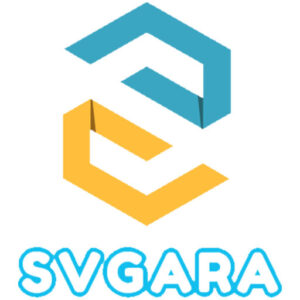BLOG
What is SVG? A Guide To Using SVG Files in Graphic Design And Common Questions
What is SVG? A Guide To Using SVG Files in Graphic Design And Common Questions
Introduction to SVG
SVG, which stands for Scalable Vector Graphics, is an XML-based format used to display two-dimensional images, charts, and graphical content on the web. Unlike traditional raster images such as JPEGs or PNGs, SVG files are vector-based, meaning they can be scaled to any size without losing quality. This makes SVG an ideal choice for web graphics, icons, logos, and intricate designs.

Why Use SVG Files?
1. Scalability: The primary advantage of SVG files is their ability to scale infinitely. Whether viewed on a small mobile screen or a large desktop monitor, SVG images retain their clarity and sharpness.
2. Lightweight: SVG files are typically smaller in file size compared to raster images, making them faster to load and ideal for web performance.
3. Editability: Because SVGs are code-based, they can be easily edited using text editors or graphic design software. This allows for quick modifications to colors, shapes, and other properties without the need for a design overhaul.
4. Interactivity: SVGs can be animated and styled with CSS, JavaScript, or even HTML, adding interactive elements to your website without relying on heavy plugins.
5. Accessibility: SVG files are text-based, making them accessible and readable by screen readers. This contributes to better web accessibility and SEO.
How to Use SVG Files in Graphic Design
SVG (Scalable Vector Graphics) files are a popular choice in graphic design due to their scalability, flexibility, and ease of use. Whether you’re creating logos, icons, or intricate designs, SVG files offer a versatile format that can be used across various platforms and software. Here’s how you can effectively use SVG files in your graphic design projects:
1. Creating SVG Files
1.1. Vector Design Software:
– Adobe Illustrator: One of the most commonly used tools for creating and editing SVG files. It allows you to design vector graphics and export them directly as SVG files.
– Inkscape: A free, open-source alternative to Illustrator, Inkscape also supports SVG file creation and editing.
– CorelDRAW: Another popular vector graphics editor that allows for the creation and export of SVG files.
1.2. Online Tools:
– Websites like Vectr, Canva, and Gravit Designer offer online platforms where you can create SVG files without needing to download software.
2. Editing SVG Files
2.1. Direct Editing in Vector Software:
– SVG files can be easily edited in vector design software. Simply open the SVG file in your preferred software, and you can modify shapes, colors, text, and other elements.
2.2. Text-Based Editing:
– Since SVG files are XML-based, they can be edited using a text editor. This is useful for making quick changes to code, such as adjusting colors or dimensions without opening design software.
2.3. Using CSS and JavaScript:
– SVG files can be styled and manipulated using CSS and JavaScript. This is particularly useful in web design where you might want to change the color of an icon or add animations.
3. Integrating SVG Files in Projects
3.1. Using SVG in Web Design:
– SVG files are commonly used in web design because they are lightweight and scalable. They can be embedded directly into HTML, used as image sources, or set as background images in CSS.
3.2. Exporting for Print:
– When designing for print, SVG files can be scaled to any size without losing quality, making them ideal for logos, banners, and other scalable graphics. Be sure to convert them to a suitable format (like PDF) if required by your printer.
3.3. Converting to Other Formats:
– SVG files can be converted to other formats like PNG, JPG, or PDF if needed. This can be done directly in most vector design software or using online converters.
4. Best Practices for Using SVG Files
4.1. Keep It Simple:
– SVG files are most effective when kept simple. Avoid overly complex designs as they can increase file size and load time, particularly on websites.
4.2. Optimize SVG Files:
– Use tools like SVGO or online SVG optimization services to reduce file size and remove unnecessary metadata before using SVG files in web or mobile projects.
4.3. Ensure Cross-Browser Compatibility:
– While most modern browsers support SVG files, it’s important to test your SVG graphics across different browsers and devices to ensure they display correctly.
4.4. Maintain Accessibility:
– When using SVG files on the web, add descriptive titles and text alternatives to ensure accessibility for users with disabilities. This also improves SEO.
5. Common Applications of SVG Files in Graphic Design
5.1. Logos and Icons:
– SVG files are ideal for logos and icons because they maintain quality at any size, whether they’re displayed on a website or printed on a large banner.
5.2. Illustrations:
– Use SVG for creating scalable illustrations that can be easily resized and reused across different media.
5.3. Infographics:
– SVG is a great format for infographics, as it allows you to maintain clarity and precision in charts, graphs, and other visual data representations.
Common Questions About SVG Files
1. Can All Browsers Display SVG Files?
Yes, modern browsers like Chrome, Firefox, Safari, and Edge fully support SVG files. However, older versions of Internet Explorer may not have full support, so it’s always a good idea to test your SVG files across different browsers.
2. How Do I Optimize SVG Files for Web Use?
To optimize SVG files for the web, consider using SVG compression tools like SVGO or online compressors. These tools remove unnecessary metadata and reduce file size without compromising quality.
3. Can SVG Files Contain Malware?
While SVG files themselves are generally safe, they can be manipulated to include malicious scripts. It’s essential to sanitize SVG files, especially if they are user-uploaded, to prevent security risks.
4. What Software Can I Use to Create SVG Files?
You can create SVG files using vector graphic design software such as Adobe Illustrator, Inkscape, Sketch, or CorelDRAW. Some online tools like Vectr or Canva also support SVG export.
5. Are SVG Files Better Than PNG?
SVG files are better than PNGs in certain contexts. If you need an image that can be resized without losing quality, such as a logo or icon, SVG is the superior choice. However, for complex images or photographs, PNG might be more suitable due to its ability to handle more detailed graphics.
6. How Can I Convert Other File Types to SVG?
You can convert raster images (like PNG, JPG) to SVG using online converters or graphic design software that supports vector tracing. Keep in mind that converting a raster image to SVG may result in a loss of detail.
Conclusion
SVG files are a powerful tool in graphic design, offering flexibility, scalability, and ease of integration across different platforms and mediums. By mastering the use of SVG files, you can create high-quality, responsive designs that look great on any device or in print. Whether you’re designing for the web, print, or digital media, SVG is an essential format to have in your toolkit.


